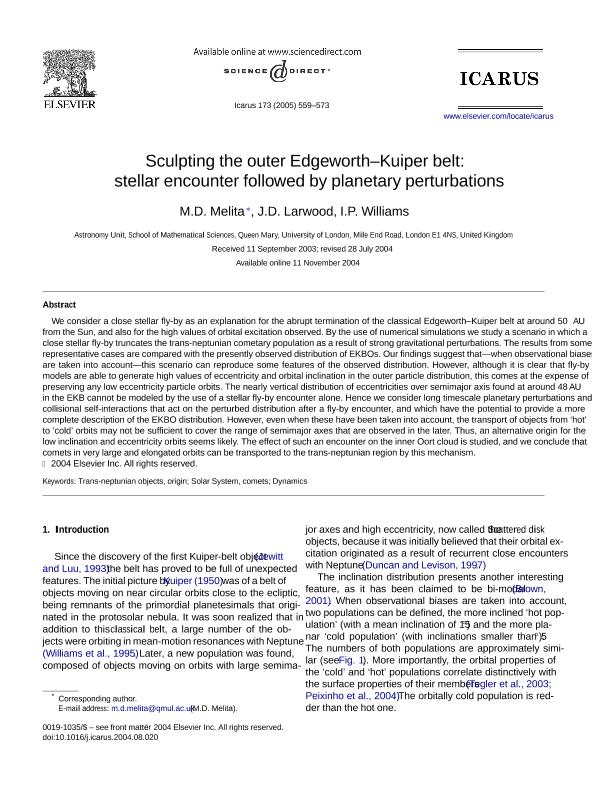Mostrar el registro sencillo del ítem
dc.contributor.author
Melita, Mario Daniel

dc.contributor.author
Larwood, J. D
dc.contributor.author
Williams, I. P.
dc.date.available
2017-07-20T20:20:22Z
dc.date.issued
2005-12
dc.identifier.citation
Melita, Mario Daniel; Larwood, J. D; Williams, I. P.; Sculpting the outer Edgeworth-Kuiper belt: stellar encounter followed by planetary perturbations; Academic Press Inc Elsevier Science; Icarus; 173; 2; 12-2005; 559-573
dc.identifier.issn
0019-1035
dc.identifier.uri
http://hdl.handle.net/11336/21038
dc.description.abstract
We consider a close stellar fly-by as an explanation for the abrupt termination of the classical Edgeworth-Kuiper belt at around 50 AU from the Sun, and also for the high values of orbital excitation observed. By the use of numerical simulations we study a scenario in which a close stellar fly-by truncates the trans-neptunian cometary population as a result of strong gravitational perturbations. The results from some representative cases are compared with the presently observed distribution of EKBOs. Our findings suggest that—when observational biases are taken into account—this scenario can reproduce some features of the observed distribution. However, although it is clear that fly-by models are able to generate high values of eccentricity and orbital inclination in the outer particle distribution, this comes at the expense of preserving any low eccentricity particle orbits. The nearly vertical distribution of eccentricities over semimajor axis found at around 48 AU in the EKB cannot be modeled by the use of a stellar fly-by encounter alone. Hence we consider long timescale planetary perturbations and collisional self-interactions that act on the perturbed distribution after a fly-by encounter, and which have the potential to provide a more complete description of the EKBO distribution. However, even when these have been taken into account, the transport of objects from `hot´ to `cold´ orbits may not be sufficient to cover the range of semimajor axes that are observed in the later. Thus, an alternative origin for the low inclination and eccentricity orbits seems likely. The effect of such an encounter on the inner Oort cloud is studied, and we conclude that comets in very large and elongated orbits can be transported to the trans-neptunian region by this mechanism.
dc.format
application/pdf
dc.language.iso
eng
dc.publisher
Academic Press Inc Elsevier Science

dc.rights
info:eu-repo/semantics/openAccess
dc.rights.uri
https://creativecommons.org/licenses/by-nc-sa/2.5/ar/
dc.subject
Asteroids
dc.subject
Comets
dc.subject
Kuiper Belt
dc.subject.classification
Astronomía

dc.subject.classification
Ciencias Físicas

dc.subject.classification
CIENCIAS NATURALES Y EXACTAS

dc.title
Sculpting the outer Edgeworth-Kuiper belt: stellar encounter followed by planetary perturbations
dc.type
info:eu-repo/semantics/article
dc.type
info:ar-repo/semantics/artículo
dc.type
info:eu-repo/semantics/publishedVersion
dc.date.updated
2017-07-20T13:08:03Z
dc.journal.volume
173
dc.journal.number
2
dc.journal.pagination
559-573
dc.journal.pais
Estados Unidos

dc.journal.ciudad
Nueva York
dc.description.fil
Fil: Melita, Mario Daniel. Consejo Nacional de Investigaciónes Científicas y Técnicas. Oficina de Coordinación Administrativa Ciudad Universitaria. Instituto de Astronomía y Física del Espacio. - Universidad de Buenos Aires. Facultad de Ciencias Exactas y Naturales. Instituto de Astronomía y Física del Espacio; Argentina. University Of London; Reino Unido
dc.description.fil
Fil: Larwood, J. D. University Of London; Reino Unido
dc.description.fil
Fil: Williams, I. P.. University Of London; Reino Unido
dc.journal.title
Icarus

dc.relation.alternativeid
info:eu-repo/semantics/altIdentifier/doi/http://dx.doi.org/10.1016/j.icarus.2004.08.020
dc.relation.alternativeid
info:eu-repo/semantics/altIdentifier/url/http://www.sciencedirect.com/science/article/pii/S0019103504002799
Archivos asociados
